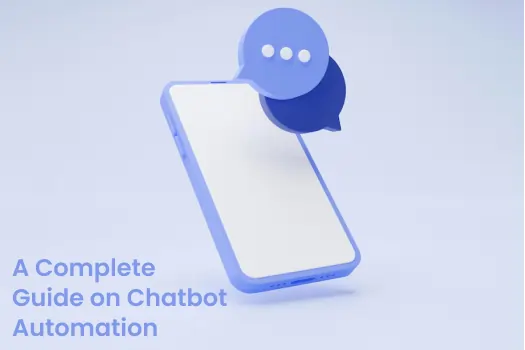Using chatbots only resulted in 80% consumer satisfaction since most chatbots are programmed to deliver accurate results.
Businesses face increasing customer demands for instant responses and round-the-clock availability in this fast-paced world.
Chatbot automation has emerged as a pivotal solution, allowing businesses to efficiently handle customer queries, streamline operations, and drive growth.
This comprehensive guide explores the essentials of chatbot automation, its benefits, types, implementation best practices, and future trends, including how chatbot marketing can drive growth and customer engagement.
What is chatbot automation?
At its core, chatbot automation involves deploying AI-driven bots to automate tasks traditionally handled by humans. These bots simulate human interaction, offering solutions ranging from customer service to lead generation.
By automating routine inquiries and tasks, chatbots free up human agents to focus on complex issues, enhancing operational efficiency and customer satisfaction.
Implementing a well-structured chatbot marketing strategy is crucial for achieving marketing goals, as it helps increase customer engagement, boost sales, and provide 24/7 support.
Integrating this with comprehensive marketing automation services can enhance its effectiveness and efficiency.
Types of chatbots

1. Rule-based Chatbots
Rule-based chatbots operate on predefined rules set by humans. They excel in straightforward interactions, such as answering FAQs and scheduling appointments through chatbot conversations, but lack adaptability beyond programmed scenarios.
2. Smart Chatbots
Smart chatbots leverage machine learning and AI to improve over time by learning from interactions. They offer more personalized responses and can handle more complex queries than their rule-based counterparts.
Additionally, smart chatbots can gather customer feedback to improve their responses over time.
3. Hybrid Chatbots
Hybrid chatbots combine elements of both rule-based and AI-driven bots. They offer flexibility and personalization while adhering to predefined rules, providing a balanced approach suitable for diverse business needs.
Additionally, hybrid chatbots can be leveraged as part of a marketing automation strategy to deliver personalized experiences while maintaining structured and efficient interactions.
How Does Chatbot Automation Work?
Chatbots utilize AI and machine learning algorithms to understand user intent and deliver relevant responses. Natural Language Processing (NLP) enables bots to interpret and respond to human language naturally, thereby improving user interaction.
Chatbots streamline data management and enhance operational efficiency by integrating with existing systems such as marketing automation tools, CRMs, and support tools.
Additionally, chatbots for marketing utilize AI and machine learning to automate marketing interactions, promote products and services, and increase customer engagement and sales through conversational marketing.
Key benefits of chatbot automation
Enhanced Customer Support and Engagement
Chatbots provide instant, 24/7 customer support. They efficiently resolve inquiries and reduce wait times, improving customer satisfaction.
Chatbots enhance the customer journey by providing instant support, improving customer experience, and streamlining interactions.
Increased Sales
Chatbots engage potential customers and contribute to higher sales conversions and revenue growth by assisting in product recommendations, handling queries, and facilitating purchases.
Operational Efficiency
Automating routine tasks reduces operational costs, boosts productivity, and allows human agents to focus on strategic initiatives that drive business growth. Chatbots assist the sales team by handling routine tasks and freeing time for strategic initiatives.
Personalized User Experience and Customer Feedback
AI-powered chatbots learn from interactions, delivering personalized responses tailored to individual customer needs and enhancing overall user experience. A marketing chatbot can enhance this by providing personalized responses tailored to individual customer needs.
Common use cases for chatbot automation
Customer Support
Chatbots handle customer inquiries, troubleshoot issues, and escalate complex queries to human agents when necessary, providing seamless customer support. Additionally, chatbots engage with website visitors to provide seamless customer support by offering instant responses and relevant updates.
Sales Enablement with Marketing Chatbots
They assist customers with product information, suggest upsells or cross-sells, and reduce cart abandonment through proactive engagement. Additionally, chatbots deliver marketing messages directly to users, encouraging sales and reducing cart abandonment.
Lead Capture and Qualified Leads
Chatbots collect customer data, engage in chatbot conversations to qualify leads based on predefined criteria, and route them to relevant sales teams for further nurturing.
Helpdesk Support
They provide initial IT support, resolve common technical issues, and give users access to knowledge-base resources for self-help.
Chatbots also gather customer feedback to improve helpdesk support by addressing customer responses and providing personalized experiences.
Social Media Monitoring
Chatbots monitor brand mentions, engage with customers in real time, and manage brand reputation on social platforms, ensuring prompt responses and customer satisfaction.
Chatbots on Facebook Messenger manage brand reputation and engage with customers in real time.
Let’s break through your revenue hurdles
We find your primary growth blockers, build expert-led strategies, and provide custom data-driven solutions to help you hit your revenue goals.
Essential features of chatbots
Omnichannel Support
Chatbots integrate across multiple platforms (website, social media, messaging apps) to deliver consistent customer experiences.
Choosing the right chatbot platform is crucial for ensuring seamless omnichannel support.
Integration with Existing Systems
They connect with CRMs, support ticketing systems, and other tools to streamline data management and ensure a cohesive customer interaction process.
Integrating chatbots with these systems can significantly enhance the overall marketing strategy by automating interactions, personalizing experiences, and improving customer engagement.
Sentiment Analysis
Chatbots analyze user emotions through sentiment analysis, adjusting responses to maintain positive engagement. This helps enhance the customer journey by tailoring interactions based on user emotions, thereby improving the customer experience and streamlining the process of generating qualified leads and closing sales
Machine Learning Capabilities
Continuous learning enables chatbots to improve performance, refining responses based on user interactions and feedback. Machine learning capabilities also help generate qualified leads by refining chatbot responses to collect information better, personalize interactions, and guide visitors toward specific actions.
Know the challenges for chatbot automation
Despite their advantages, chatbots face challenges such as public perception, nuanced understanding of human language, and cybersecurity concerns.
Implementing chatbots requires careful planning, user education, and ongoing optimization to maximize effectiveness and customer satisfaction.
- Natural Language Understanding Limitations: Despite advancements, chatbots often struggle with understanding complex, nuanced, or ambiguous language, which can lead to misinterpretations and less effective interactions.
- Integration Issues: Integrating chatbots with various systems, such as CRM platforms or other business tools, can be challenging. Ensuring smooth data flow and functionality across different platforms requires careful configuration and ongoing maintenance.
- User Experience Consistency: Maintaining a consistent and high-quality user experience can be difficult, especially if the chatbot's responses are not well-calibrated or issues are frequently encountered.
- Handling Unexpected Queries: Chatbots may struggle with unexpected or highly specific queries outside their predefined scripts or training data, leading to frustration or inadequate user support.
- Data Privacy and Security Concerns: Ensuring the security and privacy of user data handled by chatbots is crucial. Compliance with regulations and protecting sensitive information from breaches require robust security measures and continuous monitoring.
Addressing the needs of potential customers is crucial to overcoming these challenges and ensuring successful chatbot implementation.
Turn website into high paying customers
We drive business growth by optimizing every inbound channel to attract and convert high-quality clients for you
Best practices for chatbot automation success
1. Understand Your Audience
Tailor chatbot interactions based on customer preferences, demographics, and pain points to provide relevant and helpful responses. Gathering customer feedback helps in tailoring chatbot interactions based on customer preferences.
2. Develop Bot Personality
Create a conversational tone and personality that aligns with your brand identity. This will make interactions more engaging and memorable for users. A well-developed bot personality can also deliver marketing messages more effectively, ensuring users stay informed and engaged with your brand.
3. Set Clear Objectives
Define specific goals and Key Performance Indicators (KPIs) to measure chatbot performance and ensure alignment with overall business objectives. Setting clear objectives helps refine marketing strategies and measure chatbot performance effectively.
4. Test and Iterate
Conduct thorough testing to refine chatbot responses, identify gaps, and optimize user experience before full deployment, ensuring smooth operation and user satisfaction. Examples of successful chatbot marketing automation workflow include automating customer service, improving the customer journey, aiding the sales team, providing real-time support, encouraging sales, facilitating appointment bookings, promoting products and services, and sharing company news and updates.
Future trends in chatbot automation
As technology continues to advance, several key trends are shaping the future of chatbot automation:
- Advanced Natural Language Understanding (NLU): Future chatbots will leverage sophisticated NLU to understand and interpret nuanced human language better, allowing for more accurate and context-aware interactions. This advancement will enhance their ability to handle complex queries and deliver more personalized responses, integrating seamlessly with email marketing automation to provide a cohesive communication strategy.
- Seamless Integration with Omnichannel Platforms: Chatbots will increasingly integrate with various communication channels, including social media, messaging apps, and email. This omnichannel approach will ensure a consistent and cohesive customer experience across different platforms, facilitating effective email marketing automation and seamless CRM and marketing automation integration.
- Enhanced Personalization through AI and Machine Learning:AI and machine learning will enable chatbots to provide highly personalized interactions by analyzing user behavior, preferences, and historical data. This will allow tailored recommendations, proactive support, and more relevant engagement strategies, integrating smoothly with email marketing automation to create a unified customer journey.
Chatbot marketing will drive customer engagement and business growth by streamlining customer care, boosting sales, and providing personalized interactions.
How Saffron Edge can help?
At Saffron Edge, we specialize in developing and implementing advanced chatbot automation solutions tailored to your business needs.
Whether you want to enhance customer support, streamline sales processes, or improve operational efficiency, our expertise in AI, machine learning, and omnichannel integration ensures seamless deployment and measurable results.
We also specialize in developing marketing chatbots to enhance customer engagement and sales. Contact us today to learn how Saffron Edge can modernize your customer relationships and marketing efficiency approach.
Building Websites For High Conversions
Related Blogs
We explore and publish the latest & most underrated content before it becomes a trend.

Subscribe to Saffron Edge Newsletter!

Building Websites For High Conversions










